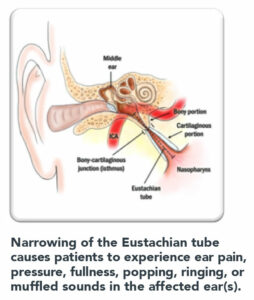 The Eustachian tube is a narrow tube which links the back of the nose to the middle ear. It is normally closed but opens when we swallow, yawn or chew. It has three main functions: to protect the middle ear from sources of disease, to ventilate the middle ear, and to help drain secretions away from the middle ear.
The Eustachian tube is a narrow tube which links the back of the nose to the middle ear. It is normally closed but opens when we swallow, yawn or chew. It has three main functions: to protect the middle ear from sources of disease, to ventilate the middle ear, and to help drain secretions away from the middle ear.
Eustachian tube dysfunction (ETD) is the inability of the Eustachian tube to adequately perform these functions and failure of the valve of the Eustachian tube to open and/or close properly.
ETD (Eustachian tube dysfunction) is estimated to effect up to 5% of the adult population.
Normally, the Eustachian tubes are working properly so you don’t notice them at all.
Anything that prevents the tube from opening or closing properly can cause Eustachian tube dysfunction.
Eustachian tube dysfunction may occur when the mucosal lining of the tube is swollen, or does not open or close properly.It can occur after the start of a cold and other nose, sinus, ear and throat infections.
When they are not working properly, the patient can possibly experience the following symptoms: muffled hearing, fullness of the ear, pain in the ear, inability to equilibrate middle ear (ME) pressure, tinnitus, and dizziness.
Persistent Eustachian Tube Dysfunction can be associated with several serious conditions.

Copyright © 2020. All Rights Reserved
Monday – Thursday
9:00AM – 5:00PM EST